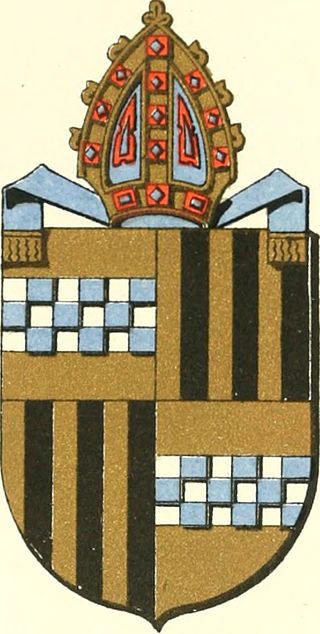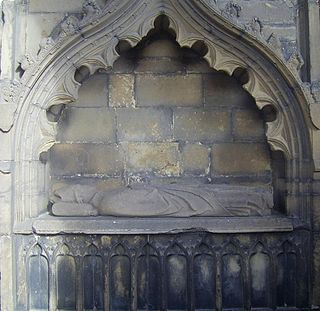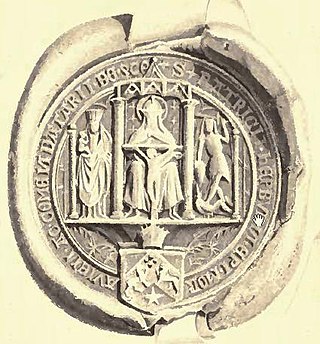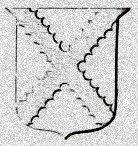Related Research Articles

The Bishop of St. Andrews was the ecclesiastical head of the Diocese of St Andrews in the Catholic Church and then, from 14 August 1472, as Archbishop of St Andrews, the Archdiocese of St Andrews.
James Nicolson (1557–1607) was Bishop of Dunkeld in 1607.
John de Ralston was a 15th-century Scottish bishop and administrator. He was regarded as illegitimate, although today his parents are not known. Ralston appears in the records for the first time in 1426, where he is chaplain and secretary to Archibald Douglas, 5th Earl of Douglas. He retained this position on the death of Douglas in 1439. Between 1429 and 1443 he served as the fourth provost of Bothwell Collegiate Church, the home church of the Douglas earls. On 26 November 1445 he became dean of the diocese of Dunkeld.
James Livingston was a 15th-century cleric from East Lothian in south-eastern Scotland. Born at an unknown date in the 15th century, he was a son of the Laird of Saltcoats. He chose a career in the church, and became rector of the churches of Forteviot and Weme, and vicar of Innerleithen. By 1474, if not earlier, he had become dean for the whole diocese of Dunkeld. After the death of Thomas Lauder, Livingston was chosen as his successor as Bishop of Dunkeld. Although Livingston's appointment was contested at Rome by Thomas Spens, Bishop of Aberdeen, who wanted to be translated to Dunkeld, Livingston was consecrated on 30 June 1476. Livingston's episcopate is relatively obscure; he spent a good deal of time in Edinburgh, where he is witness to several charters. He died at Edinburgh, on 28 August 1483. He was buried in Inchcolm.

Andrew Stewart was a 16th-century Scottish noble and cleric. He was a legitimate son of John Stewart, 1st Earl of Atholl and Eleanor Sinclair, daughter of William Sinclair, Earl of Orkney. His paternal grandmother was Joan Beaufort, former queen-consort of Scotland. Andrew chose an ecclesiastical career, held a canonry in Dunkeld Cathedral and was rector of Blair parish church, a church under the control of the earls of Atholl.

Robert Cockburn was a 16th-century Scottish diplomat and cleric.
Donald Campbell was a 16th-century Scottish noble and churchman. He was the son of Archibald Campbell, 2nd Earl of Argyll and Elizabeth Stewart, daughter of John Stewart, 1st Earl of Lennox. From 1522, he was a student of St Salvator's College, at the University of St Andrews. After graduation, he became a cleric in his home diocese, the diocese of Argyll.
James Paton was a 16th-century Scottish cleric from Ballilisk, an estate in the parish of Muckhart, west of Kinross. As Ballilisk appears to have been a rectory serving the adjacent chapel at Muckhart his family are presumed to have included priests who served the parish in Pre-Reformation days.

John de Winchester was a 15th-century English cleric who distinguished himself as an administrator and bishop in Scotland. Winchester was a student of canon law from 1418, graduating with a bachelorate in 1421.

Patrick Hepburn was a 16th-century Scottish prelate. He served as both pre- and post-Reformation Bishop of Moray.
Simon de Wedale was a 14th-century Augustinian canon who rose to become Abbot of Holyrood and then Bishop of Galloway. Little is known of Simon until he appears on 27 February 1321 as Abbot of Holyrood Abbey near Edinburgh. His accession to this abbacy had only been recent, since either in January of this year or in January 1320, his predecessor Elias, ruling the abbey since at least 1309 and probably earlier, was still abbot. Abbot Simon occurs again in the records on 10 June 1326.
Symeon is the second known Bishop of Ross in the 12th century. His predecessor Mac Bethad occurred as bishop in a document datable between 1127 and 1131.
David Panter [also written Painter, or Paniter], Scottish diplomat, clerk and bishop of Ross, was the illegitimate son of Patrick Paniter, secretary to James IV; his mother was Margaret Crichton, illegitimate daughter of William Crichton, 3rd Lord Crichton and widow countess of Rothes.
John Fraser [also, more commonly then, Frisel or Frisell] was a late medieval Scottish prelate. Born about 1429, or 1430 if later tradition can be believed, with strong connections to the burgh of Linlithgow, Fraser held a variety of high-level ecclesiastical positions in Scotland, including being the first Dean of Restalrig collegiate church before becoming Bishop of Ross in 1497, a position he held until his death in 1507.
John Bullock O.S.A. was an Augustinian canon and prelate active in the 15th century Kingdom of Scotland. While earning a university degree between 1409 and 1417, Bullock gained several benefices in Scotland, and claimed the headship of St Andrews Cathedral Priory before becoming Bishop of Ross in 1418. He held the latter position until his death, which occurred in either 1439 or 1440.

Nicholas de Balmyle, also called Nicholas of St Andrews, was a Scottish administrator and prelate in the late 13th century and early 14th century. A graduate of an unknown university, he served his earliest years as a clergyman at St Andrews, moving on to hold churches in Lothian as well as deputising to two archdeacons of Lothian.
Jonathan was a churchman and prelate active in late twelfth- and early thirteenth century Strathearn, in the Kingdom of Scotland. He was the Bishop of Dunblane during the time of Gille Brigte of Strathearn, and it was during Jonathan's episcopate that Gille Brigte founded an Augustinian priory at Inchaffray.
Séon Carsuel was a 16th-century Scottish prelate, humanist, and Protestant reformer. Born early in the century, when Carsuel completed his education he joined the service of the Protestant Earl of Argyll, tutoring his son and using his patronage to obtain benefices, most notably becoming Bishop of the Isles in 1565. Standing at over 7 feet in height, Carsuel was an important figure in the history of Scottish Gaelic, as in 1567 his Foirm na n-Urrnuidheadh, the Gaelic translation of the Book of Common Order, became the first work to be printed in any Goidelic language.
John de Crannach was a 15th-century Scottish scholar, diplomat and prelate. Originating in the north-east of Lowland Scotland, he probably came from a family associated with the burgh of Aberdeen. Like many of his relatives, he flourished in the 15th-century Scottish church. After just over a decade at the University of Paris, Crannach became a servant of the then Dauphin Charles (VII).
James Hamilton was a Scottish churchman who served as Bishop of Argyll both pre- and post-Reformation and as Sub-Dean of Glasgow.
References
- ↑ Watt, Fasti Ecclesiae, p. 357.
- ↑ Watt, Fasti Ecclesiae, p. 109.
- ↑ Watt, Fasti Ecclesiae, p. 277.
- 1 2 3 Yellowlees, Michael (2010). "The Ecclesiastical Establishment of the Diocese of Dunkeld at the Reformation". The Innes Review. 36 (2): 74–85. doi:10.3366/inr.1985.36.2.74 – via Edinburgh University Press.
- 1 2 3 Dowden, Bishops of Scotland, pp. 88-92; Watt, Fasti Ecclesiae, p. 100.
- ↑ Dowden, Bishops of Scotland, pp. 88-92
- 1 2 3 4 Watt, Fasti Ecclesiae, p. 100.
- ↑ Dowden, Bishops of Scotland, p. 93; Watt & Shead, Heads of Religious Houses, p. 130.
- ↑ Dowden, Bishops of Scotland, p. 94; Foggie, "Hamilton, John (1510/11–1571)".
- ↑ Dowden, Bishops of Scotland, p. 94.
- ↑ Hewitt, "Castilians in Edinburgh (act. 1570–1573)".
- 1 2 Dowden, Bishops of Scotland, p. 93; Hewitt, "Castilians in Edinburgh (act. 1570–1573)".
- ↑ Dowden, Bishops of Scotland, p. 93; Watt, Fasti Ecclesiae, p. 100